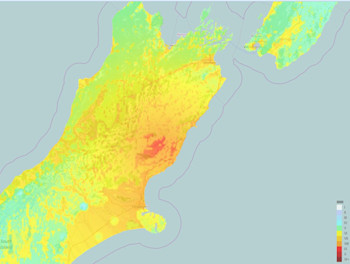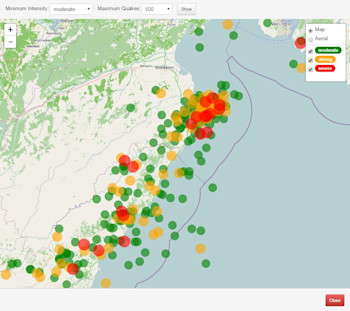
M7.8 Kaikoura Earthquake: Latest updates
We are getting more information from our science reconnaissance teams and are sifting through the mountains of data to develop a better picture of this earthquake.
We have new information about the fault ruptures, and have initial estimates on which faults were involved. Here is a catalogue of our latest stories.
__ Stories __
Updated Aftershock Forecast NIWA’s offshore mapping adds more faults to the latest Kaikoura fault rupture map Coastal uplift along the North Canterbury-Marlborough coast – results from the coastal survey team Standing in cracks and clambering up scarps – what have our earthquake geologists been doing? Did you see any evidence of the tsunami after the Kaikoura earthquake? What do these slow-slip events mean for future large earthquakes? Kekerengu Fault has a Word to its Geologists Gisborne and Hawke's Bay slow-slip event follows M7.8 Kaikoura Quake (includes Porangahau information, updated 26/11/2016) How is the Kaikoura aftershock sequence behaving compared to the forecast? Watching the M7.8 Kaikoura Quake Dominos Fall in Real Time M7.8 Kaikoura Quake: Future Scenarios and Aftershock Forecasts Coastal Uplift: How has the Kaikoura Coastline Changed Landslides and Landslide dams caused by the Kaikoura Earthquake GPS allowed rapid detection of land movements due to M7.8 earthquake More info on the impact of Monday's tsunami
Latest Videos
Kaikoura Earthquake computer simulation: How the Earthquake shaking evolved across New Zealand Kaikoura Earthquake 2016: Paptea Fault Rupture (Kelvin Berryman explains it all!) Kaikoura Earthquake: Papatea Fault Drone flyover Kaikoura Earthquake 2016: GeoNet in the Field Drone video of the Kekerengu Fault rupture
Multiple ruptures
Rapid field reconnaissance indicates that multiple faults have ruptured: Kekerengu Fault at the coast - appears to have had up to 10m of slip Newly identified fault at Waipapa Bay Hope Fault - seaward segment - minor movement Hundalee Fault
Other faults have also been identified as being involved in the earthquake. In the simplest case an earthquake is a rupture on a single fault plane. What we are finding in New Zealand is that quite a few of our larger earthquakes involve jumping from rupture on one plane to another in a complex sequence. We first saw that with the Darfield Sept 2010 EQ where multiple segments ruptured together as a single earthquake. We appear to have seen this again overnight.
In terms of what might happen next: The scenarios provide an overview of how we see this earthquake sequence evolving over the next few days to one month. What is on the web page is our best information that we have to hand at the moment. As our science information flows in over the next few days we expect that information may evolve.
A word about the Moon
Some people have raised concerns about a link with the supermoon. In large groups earthquakes exhibit slight associations with lunar cycles, but this is not reliable for forecasting. We have two tides a day throughout New Zealand and at any one place there is no clear association in location. The occurrence of the full moon around the globe does not allow us to say how big, when and where any earthquake might be.
Long term earthquake rates
There were more large earthquakes in a period of several decades prior to about 1950, and it has been relatively quiet since then. Since the M7.8 in July 2009 in Fiordland, that quiet period appears to be over. The reason we had a tsunami generated by an earthquake with an epicentre onshore is that there was deformation further down the fault plane offshore.
Wellington area
Wellington area faults and the subduction interface beneath Wellington are captured in the probability table and the scenarios given there. We do not have any evidence of an impending large earthquake of a similar size in Wellington at this stage but we cannot rule this out. We cannot make a calculation to predict this, but the chance of a further shock in the Wellington area has increased somewhat since the Kaikoura earthquake.
Why were our magnitudes different from the USGS: About magnitude variability
We have changed the New Zealand local magnitude for this earthquake to M7.8.
__ Looking forward__
We will be continuing to gather information about this earthquake for some time. We will continue to keep updating information as we learn more about this earthquake.
Be prepared – both physically and mentally
Beyond physical preparedness is the emotional and psychological support for these earthquakes. The All Right? Hotline (0800-777-846) is a great resource where you can talk about any anxieties or concerns that you have regarding the earthquakes.



